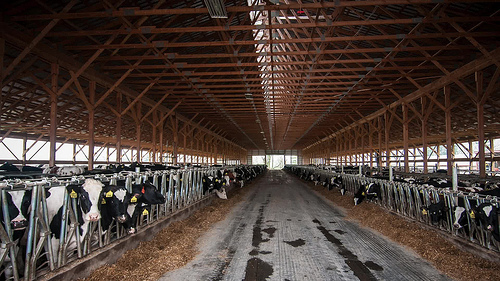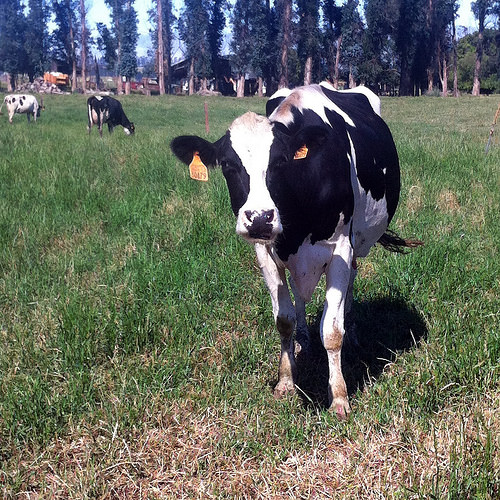Some cool benefits of eating organic images:
20110419-RD-LSC-0910 – REAP Grant – Cow Powered Farm

Image by USDAgov
Transcript below caption.
The U.S. Department of Agriculture (USDA), Rural Development (RD) USDA Rural Energy for America Program (REAP) grant assisted the Brubaker Farms a diary and green energy producer in Mount Joy, PA on April 19, 2011 with an Methane Anaerobic Digester. The family farm owned by Luke, Mike and Tony Brubaker has approximately 850 cows and 700 young stock, producing 20,200,000 pounds of milk last year. It has 13 full-time employees and more than 1,500 acres of farmland. The digester can handle more than 41,859 metric tons of organic waste, to capture methane that powers a low emission generator producing 210 kWh that powers the digester and farm operations. Excess power is sold to the local power grid, allowing the community to benefit from a green energy source. After producing methane, effluent from the digester is pressed to separate liquid and solid materials. The farm uses the liquids in fertilizer; and solids become the cows’ bedding for Brubaker and other local farms, that is cleaner than sawdust. Mount Joy residents can enjoy the fact that the process removes 90% of the odor from the cow manure. The methane itself is odorless and colorless. The system can accept an additional 2,600 gallons of food waste per day from local sources that would otherwise dispose of it in a local landfill. Additionally, their nutrient credits can be sold to the local municipality to help it to meet federal requirements and to keep sewer bills from rising. These provide additional revenue for the farm, and environmentally friendly community partnerships. USDA Multimedia by Lance Cheung.
00:00 Text: United States Department of Agriculture
00:06 Text: Brubaker Farms, Mount Joy, PA
Music: Banjo, fiddle and drums playing country music.
Photo: Far away farm in distance with an overcast sky.
00:11 Text: Dairy and Energy Producer
Music: Banjo, fiddle and drums playing country music.
Photo: Large dairy farm buildings fills width of image, with farm field in foreground, and overcast sky above it.
00:15 Text: Multiple Green Revenues
Music: Banjo, fiddle and drums playing country music.
Photo: Entire length of a free stall barn with overcast sky above it.
00:19 Text: Methane Digester
Music: Banjo, fiddle and drums playing country music.
Photo: Ends of two free stall barns and two smaller buildings and the black rubber covered tank partially exposed above a grass area near buildings.
00:23 Text: 850 cows producing more than 20 million pounds of milk per year.
Music: Banjo, fiddle and drums playing country music.
Photo: Inside of free stall barn showing frame work above and heifers (black and white dairy cows) filling the free stall area below, except for a driveway in the middle.
00: 27 Text: 13 Full-time employees.
Music: Banjo, fiddle and drums playing country music.
Photo: Inside a free stall barn showing heifers with heads through open stalls facing the center driveway, eating feed on the floor. A tractor is seen at the far end of the barn.
00:31 Mike Brubaker: “Mike Brubaker, Brubaker Farms”
Photo: Close up of the nose of a cow peering at camera from between fence bars.
00:33 Mike Brubaker: “Currently I am standing in front of our…
Text: Co-owner Mike Brubaker
Video: Mike Brubaker standing on gravel road between barn and methane digester generator building.
00:36 Mike Brubaker: “… methane digester project. And…”
Photo: Mike Brubaker standing on the black rubber covering of the methane digester vessel (a portion of the approximately two foot high circular wall, more than 30 feet in diameter, and partially buried structure is seen).
00:40 Mike Brubaker: “…to my left, right here, are some reception pits under the concrete cap, with some pumps that feed…
Video: Mike Brubaker standing on gravel road between barn and methane digester generator building and underground reception pits with exposed pumps. He uses his left arm to indicate the pits.
00:45 Mike Brubaker: “…the digester unit…”
Video: Time-lapse video of digester with overcast skies moving quickly above it.
00:47 Mike Brubaker: “…over there with the black cover on it…”
Photo: Closer view of digester cover with overcast skies above it.
00:49 Mike Brubaker: “And then directly behind me is the engine building…”
Video: Mike Brubaker standing on gravel road between barn and methane digester generator building and underground reception pits with exposed pumps. He uses his left arm to indicate the building.
00:52 Mike Brubaker: “…that has an engine in it that is running all the time…”
Text: Father and co-owner Luke Brubaker
Photo: Luke Brubaker sitting on bench in front of methane powered engine and electrical generator.
00:55 Mike Brubaker: “…from the methane coming out of the digester vessel.
Photo: Red banner on wall …”COW POWER”
01:00 Mike Brubaker: “We are generating electric all the time, 24/7. And currently, we been producing about 210 kilowatts per hour, 24/7”
Photo: Close up view of generator and portion of engine connected to it.
01:11 Mike Brubaker: “A portion of that, we use. But, then a majority of it goes…”
Photo: Row of cows eating feed in the barn.
01:15 Mike Brubaker: “…right out to the grid. It’s hooked up to the utility company’s grid through the transformers on the telephone pole”
Photo: Digester project area with utility pole.
01:20 Mike Brubaker: “So we are selling. Selling all excess to the utility company. We are making the equivalent of enough electric…”
Video: Mike Brubaker standing on gravel road between barn and methane digester generator building and underground reception pits with exposed pumps. He uses his right arm to indicate the utility pole.
01:27 Mike Brubaker: “to supply 200 houses with electric, all the time. So we are making our neighbors happy by supplying them with green renewable electric.”
Photo: View of top of digester cover, with row of homes at edge of farm field.
01:40 Mike Brubaker: “Aside benefit of methane digestion is not only that we’re producing methane, which is a fuel to make electric; the effluent coming out of the digester has lost 90% of it’s odor.”
Video: Mike Brubaker standing on gravel road between barn and methane digester generator building.
01:55 Mike Brubaker: “So when we apply the nutrient liquid portion to…”
Photo: View farm with green fields, silos, and free stall barn.
02:00 Mike Brubaker: “…the fields around us and close to the houses, maybe next to their back yards.”
Photo: View of neighboring homes along edge of farm fields.
02:04 Mike Brubaker: “The odor has been drastically reduced. It can help keep our neighbors happy. It’s a good public relations thing”
Photo: Luke Brubaker hand feeding some cows in the barn.
02:10 Mike Brubaker: “…to lower manure.”
Photo: Local brick house on hillside, in a wooded area.
02:17 Photo: Side of barn.
02:20 Text 20110419-RD-LSC-0910
USDA Multimedia by Lance Cheung.
Music "Campfire" by Apple
02:24 USDA Logo
Text: United States Department of Agriculture
Holstein on Pasture

Image by DARLA SCHOENROCK
FIELD NOTES:
Notes from the tour:
McClelland family raise Holsteins, Jerseys and Brown Swiss cows. Their breeding philosophy has changed to a more economically compact cow that can walk further, a more pasture-based cow.
FIELD NOTES FROM THE FARM DISCOVERY TOUR EVENT:
Pasturing is the cornerstone of organic dairy. The same things that are good for us — fresh air, sunshine, exercise, eating right — are also good for cows.
Cows are ruminants. This means that they are designed to eat grass and pasture plants are the best possible food for a cow, and the best organic milk begins in the pastures where cows graze healthy, nutrient-dense plants grown in healthy soil which makes their milk nutritious and great tasting. That’s good for people and the planet.
The McClelland’s produce some of the finest artisan organic dairy products and cattle in the beautiful rolling hills of Sonoma County, California. They currently milk 800 cows and farm over 600 acres in the Two Rock Valley near Petaluma, California, which is known for its cools coastal climate that is perfect for raising cattle. The milking animals are grass fed on over 500 acres of pasture. In 2000, they decided to diversify their operation, and over a three-year period they transitioned their herd to organic practices.
The McClelland family are committed to the health and well-being of their cows, their land and their customers. They have created a farming environment where nature is a priority and their cows thrive. The family is motivated to preserve the environment in and around their dairy. The cows provide fertilizer for the native grasses on which they graze and they eliminate the need to harvest feed. The view the land as a legacy to the generations of McClellands yet to come.
The farm has always been a pasturing operation but, since they have been organic for seven years, they have gotten into intensive rotational grazing. Instead of having just a few fields for their milking cows, they rotate them through 45 smaller paddocks on 500 acres. Grazing is a big part of their operation and continues to grow. They see the benefit in cow health, their milk and in their feed costs. The grazing practices work better for the environment, as well.
They have changed their pasture content management quite a bit, too. They ware dry land farming and tinker with the mix constantly to keep grasses growing as much of the year as possible. The biggest challenge for graziers is always figuring out what worlds best in their area.
The Grass is Greener: Melinda Hemelgarn: www.organicvalley.coop/community/beyond-the-plate/the-gra…
Organic Production Enhances Milk Nutritional Quality by Composition: A United States-Wide, 18-Month Study,” Benbrook, C., et al. , PLOS One, Dec. 2013. www.plosone.org/article/info:doi/10.1371/journal.pone.008…
Union of Concerned Scientists: Greener Pastures: How Grass Fed Beef and Milk Contribute to Healthy Eating: Pasture raised cattle produce healthier beef and milk— and a healthier environment — than their feed lot counterparts. www.ucsusa.org/food_and_agriculture/solutions/advance-sus…
The Farm Discovery Tour: ov.coop/farmdiscovery
The McClelland Farm: www.mcclellandsdairy.com/FarmTours.htm
060615 OV McClelland Farm Discovery Tour HERO
4130
